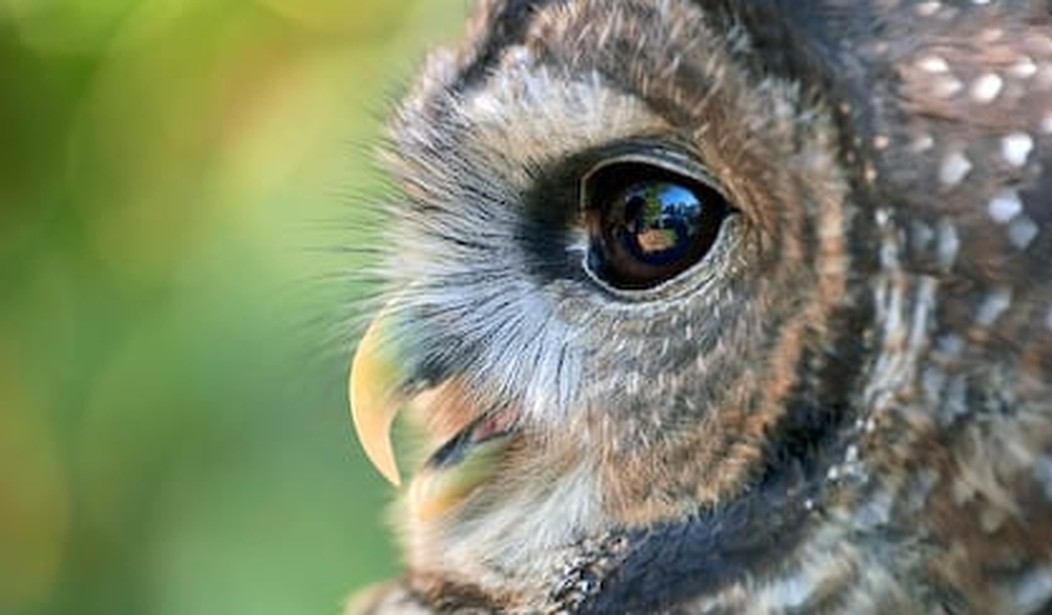President Obama didn’t just pardon a couple of turkeys at the White House yesterday, but unveiled a plan to nearly double protected habitat for the Northern Spotted Owl.
The birds have been classified as a threatened species since 1990, and environmental groups went to court to expand the 5.3 million acres dedicated to protecting the bird under the Bush administration. The federal government “finalized a science-based proposal identifying lands in the Pacific Northwest that are essential to the survival and recovery of the northern spotted owl.”
But the House Natural Resources Committee chairman — from one of the affected states, Washington — warned that the final critical habitat rule released by the Interior Department could further endanger thousands of jobs in an industry that has already taken a hit.
“The Obama Administration spent months working to revise a plan that was fatally flawed from the beginning. While this final rule must be fully reviewed, I remain very concerned that it will cost millions of taxpayer dollars and lock up large portions of federal land without addressing the root of the issue, the predatory Barred Owl,” said Rep. Doc Hastings (R-Wash.).
The U.S. Fish and Wildlife Service said that the final designation is “based on the best available science … including feedback from experts, regional stakeholders, land management agencies and public comment.”
It reduces the amount of critical habitat in California, Oregon and Washington that was proposed last February by 4.2 million acres. All private lands and the significant majority of state lands identified in the proposal have been excluded from the final rule, according to Fish & Wildlife.
However, the designation can apply to any private or state lands if proposed activities involve federal funding or permitting.
“Expanding the Northern Spotted Owl’s critical habitat will further endanger the timber industry, the thousands of jobs that the industry supports, and forest health,” Hastings said.
Saying that the overall spotted owl population is declining at a rate of 2.9 percent per year, the service designated 9.29 million acres of critical habitat on federal land and 291,570 acres on state land.
There are about 3,000 to 5,000 spotted owls in the region, and conservationists say their numbers have dropped 40 percent in the past 25 years — a time period in which the owl became a poster bird for industry vs. environmentalists.
“The BLM and the USFWS have worked together to try to find the sweet spot – providing for the required conservation of the northern spotted owl and recognizing the importance of BLM lands to the social fabric of western Oregon. This rule is a direct result of those interactions” said Jerome Perez, Oregon/Washington state director for the Bureau of Land Management.
“We applied the best available science to identify the remaining habitat essential to the spotted owl’s recovery – and to ensure that our recovery partners have the clarity and flexibility they need to make effective land management decisions,” said Robyn Thorson, director of the Fish & Wildlife Service’s Pacific Region. “We fully support conservation strategies and forest treatments that restore the health and natural dynamics of entire forest ecosystems to sustain all their many values.”
Hastings stressed that more than timber jobs are at stake with the new rules, though — and warned that the owl could be hurt even more by ostensible measures to save it by restrictions on cutting dangerous forest growth.
“The 2012 wildfire season has been one of the worst on record. Washington state alone saw over 300,000 acres burned, including over 35,000 acres of current and proposed spotted owl habitat,” the chairman said. “The Forest Service has also reported that the additional loss of habitat from post-fire beetle infestation would ‘adversely impact the spotted owl population.'”
And even with the years-long battle over the habitat between environmentalists and loggers, the spotted owl faces a threat from their own kind instead of humankind.
Some spotted owl conservation plans, including a proposal earlier this year from Fish & Wildlife, have called for killing or removing the larger, hardier, more aggressive barred owls that have migrated from the East Coast to encroach on the spotted owls’ territory and have been witnessed interbreeding or killing the little spotted birds, as well as taking their food and destroying nests.
Environmental groups cried foul, though, and accused land managers of using the barred owl as a scapegoat.
Conservation groups also said they were disappointed that the all private and most state lands were excluded from yesterday’s rule.
Noah Greenwald, endangered species director at the Center for Biological Diversity, said the land designation “marks the end of a dark chapter in the Endangered Species Act’s implementation when politics were allowed to blot out science.”
“It is, however, deeply disappointing that the Obama administration has elected to exclude all private and most state lands, which are absolutely essential to the recovery of the spotted owl and dozens of other wildlife species,” Greenwald said.
“The evidence is overwhelming that redwood forests are essential to the conservation of the species. Leaving them out of the final rule is a big mistake,” said Andrew Orahoske, conservation director for the Environmental Protection Information Center.
Conservation groups also remain concerned about statements in the proposed critical habitat rule calling for “active management” of spotted owl critical habitat, including logging.
“The owl needs these areas of protected habitat to survive,” said Steve Holmer, senior policy advisor for American Bird Conservancy. “We remain concerned, however, that Fish and Wildlife may allow increased logging in critical habitat, which could also imperil the threatened marbled murrelet, and help the spotted owl’s competitor, the barred owl.”
As both sides panned the decision as not going far enough to protect either the owl or the jobs, conservationists are far more likely to have greater pull with the administration in the end. Defenders of Wildlife, for one, hailed Obama’s re-election as a win for environmentalists, then laid on the pressure.
“The president should reaffirm his past promise to let science guide natural resource policy in his administration. Important conservation policy decisions need to be grounded in and guided by sound science and not be driven by what is politically expedient,” said the group’s president, Jamie Rappaport Clark, earlier this month. “That should be something we all agree upon.”
Hastings, though, is holding out for a deal that all sides truly agree on.
“We need a solution based on sound science that will allow for active management to improve forest health, increase economic opportunity and jobs for our rural communities and schools, while also addressing the Barred Owl and protecting the Northern Spotted Owl from catastrophic wildfire,” he said.









Join the conversation as a VIP Member